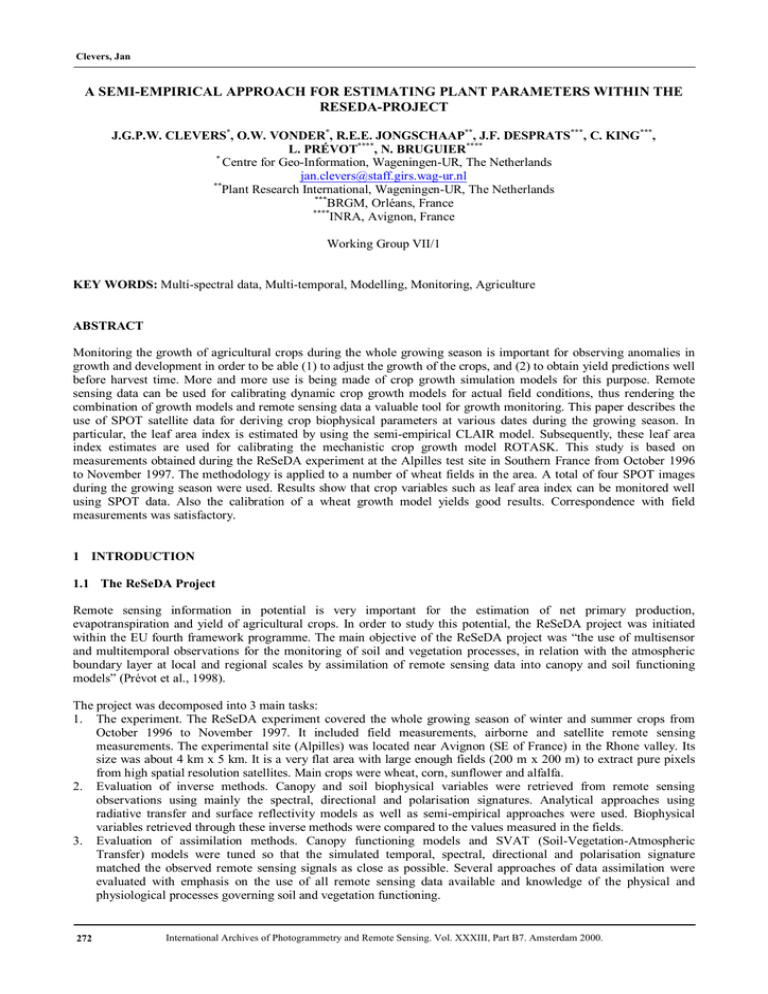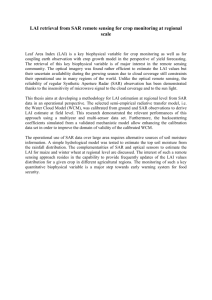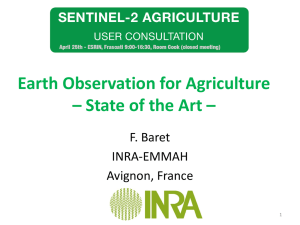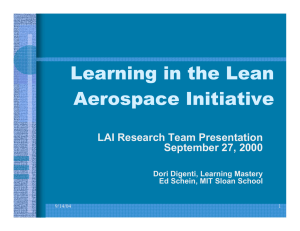A SEMI-EMPIRICAL APPROACH FOR ESTIMATING PLANT PARAMETERS WITHIN THE RESEDA-PROJECT
advertisement

Clevers, Jan A SEMI-EMPIRICAL APPROACH FOR ESTIMATING PLANT PARAMETERS WITHIN THE RESEDA-PROJECT J.G.P.W. CLEVERS*, O.W. VONDER*, R.E.E. JONGSCHAAP**, J.F. DESPRATS***, C. KING***, L. PRÉVOT****, N. BRUGUIER**** * Centre for Geo-Information, Wageningen-UR, The Netherlands jan.clevers@staff.girs.wag-ur.nl ** Plant Research International, Wageningen-UR, The Netherlands *** BRGM, Orléans, France **** INRA, Avignon, France Working Group VII/1 KEY WORDS: Multi-spectral data, Multi-temporal, Modelling, Monitoring, Agriculture ABSTRACT Monitoring the growth of agricultural crops during the whole growing season is important for observing anomalies in growth and development in order to be able (1) to adjust the growth of the crops, and (2) to obtain yield predictions well before harvest time. More and more use is being made of crop growth simulation models for this purpose. Remote sensing data can be used for calibrating dynamic crop growth models for actual field conditions, thus rendering the combination of growth models and remote sensing data a valuable tool for growth monitoring. This paper describes the use of SPOT satellite data for deriving crop biophysical parameters at various dates during the growing season. In particular, the leaf area index is estimated by using the semi-empirical CLAIR model. Subsequently, these leaf area index estimates are used for calibrating the mechanistic crop growth model ROTASK. This study is based on measurements obtained during the ReSeDA experiment at the Alpilles test site in Southern France from October 1996 to November 1997. The methodology is applied to a number of wheat fields in the area. A total of four SPOT images during the growing season were used. Results show that crop variables such as leaf area index can be monitored well using SPOT data. Also the calibration of a wheat growth model yields good results. Correspondence with field measurements was satisfactory. 1 INTRODUCTION 1.1 The ReSeDA Project Remote sensing information in potential is very important for the estimation of net primary production, evapotranspiration and yield of agricultural crops. In order to study this potential, the ReSeDA project was initiated within the EU fourth framework programme. The main objective of the ReSeDA project was “the use of multisensor and multitemporal observations for the monitoring of soil and vegetation processes, in relation with the atmospheric boundary layer at local and regional scales by assimilation of remote sensing data into canopy and soil functioning models” (Prévot et al., 1998). The project was decomposed into 3 main tasks: 1. The experiment. The ReSeDA experiment covered the whole growing season of winter and summer crops from October 1996 to November 1997. It included field measurements, airborne and satellite remote sensing measurements. The experimental site (Alpilles) was located near Avignon (SE of France) in the Rhone valley. Its size was about 4 km x 5 km. It is a very flat area with large enough fields (200 m x 200 m) to extract pure pixels from high spatial resolution satellites. Main crops were wheat, corn, sunflower and alfalfa. 2. Evaluation of inverse methods. Canopy and soil biophysical variables were retrieved from remote sensing observations using mainly the spectral, directional and polarisation signatures. Analytical approaches using radiative transfer and surface reflectivity models as well as semi-empirical approaches were used. Biophysical variables retrieved through these inverse methods were compared to the values measured in the fields. 3. Evaluation of assimilation methods. Canopy functioning models and SVAT (Soil-Vegetation-Atmospheric Transfer) models were tuned so that the simulated temporal, spectral, directional and polarisation signature matched the observed remote sensing signals as close as possible. Several approaches of data assimilation were evaluated with emphasis on the use of all remote sensing data available and knowledge of the physical and physiological processes governing soil and vegetation functioning. 272 International Archives of Photogrammetry and Remote Sensing. Vol. XXXIII, Part B7. Amsterdam 2000. Clevers, Jan This paper will focus on two aspects of the project: • Application of a semi-empirical approach for estimating the leaf area index (LAI) from high resolution optical satellite data at different moments during the growing season. Results are compared with field measurements. • Assimilation of the LAI estimates into a calibrated crop growth model. The simulated LAI and final yield are compared with field measurements. 1.2 Crop Yield Prediction Monitoring the growth of agricultural crops during the whole growing season is important for observing anomalies in growth and development in order to be able to adjust the growth of the crops, and to obtain yield predictions well before harvest time. More and more use is being made of crop growth models for this purpose. Remote sensing data can be used for calibrating growth models for actual field conditions, thus rendering the combination of growth models and remote sensing data a valuable tool for growth monitoring (Maas, 1988; Bouman, 1991; Delécolle et al., 1992; Clevers et al., 1994). A key variable used for calibrating a crop growth model is the LAI. The LAI may be obtained from optical remote sensing data by analytically inverting a radiative transfer model. However, best results are obtained by using a semiempirical approach (using a vegetation index) in estimating the LAI regularly during the growing season (Clevers et al., 1994). Mechanistic and dynamic crop growth models describe the relationship between plant physiological processes and environmental factors such as solar irradiation, temperature, and water and nutrient availability. They simulate daily growth and development of crops, and finally a simulation of yield at harvest time is obtained. As such these models may also be used for yield prediction early in the growing season by assuming average meteorological conditions. However, it is advisable to “check” modelling results with some sort of information on the actual status of the crop throughout the growing season. Optical remote sensing can provide such information (Clevers, 1988; Bouman, 1991). One possibility is to force the model simulation through obtained LAI estimates by resetting the simulated LAI value to the retrieved LAI value at a remote sening event. Another possibility is to force interpolated LAI values retrieved by remote sensing. 2 METHODOLOGY First, a simple reflectance model (CLAIR) is used for estimating the LAI from optical data. Subsequently, these LAI values are forced on the calibrated simulation model in two ways: 1) A reset of the simulated LAI values by the LAI values retrieved from three of the four SPOT images (3x reset), and 2) force the interpolated SPOT LAI values continuously on the simulation model (every day, between 1st, 2nd, 3rd and 4th SPOT image). 2.1 Estimating Leaf Area Index Complex physical reflectance models usually simulate reflectance for varying crop characteristics and incorporate simplified structural and optical properties of the canopy. Such models are very useful for sensitivity analyses in order to investigate the influence of crop characteristics and external variables on reflectances or simple vegetation indices. Moreover, they are very valuable for investigating boundary conditions to the application of certain simplifying relationships. However, they are difficult to invert and too complicated for practical applications. Clevers (1988, 1989) derived a simplified, semi-empirical reflectance model for estimating LAI (CLAIR model). In this model, first, the WDVI (weighted difference vegetation index) is ascertained as a weighted difference between measured near-infrared (NIR) and red reflectances, assuming that the ratio of NIR and red reflectances of bare soil is constant. In this way a correction for the influence of soil background is performed: WDVI = NIR - (C × Red) (1) NIR = total measured NIR reflectance; Red = total measured red reflectance; C = slope of the (soil-specific) soil line, or ratio between NIR and red reflectance of soil. Subsequently, this WDVI is used for estimating LAI according to the inverse of an exponential function: International Archives of Photogrammetry and Remote Sensing. Vol. XXXIII, Part B7. Amsterdam 2000. 273 Clevers, Jan LAI = -1/α × ln(1 - WDVI/WDVI∞), (2) with α as a parameter describing the rate with which the function of equation (2) runs to its asymptotic value, and WDVI∞ as the asymptotic limiting value for WDVI. Bouman et al. (1992) validated the CLAIR model for various crops. They used field-based reflectance measurements obtained in The Netherlands over different experimental fields during a large number of years. For instance, for winter wheat they found for α a value of 0.400 and for WDVI∞ a value of 47.0 if the WDVI is based on NIR and green reflectance. They found a single regression line that was not significantly different for cereals like wheat, barley and oats during the whole growing season. Clevers and Van Leeuwen (1996) showed that such field-based parameter estimates could well be applied to airborne measurements. Clevers (1991) found a similar regression line for barley at the vegetative stage, whereby the reflectances now were derived from calibrated aerial photographs. However, for the barley crop at the generative stage the regression line was significantly different. This was also found by others, e.g. Ahlrichs and Bauer (1983). Clevers (1991) obtained for α a value of 0.252 at the vegetative stage and for WDVI∞ a value of 68.6 if the WDVI is based on NIR and red reflectance. At the generative stage he obtained for α a value of 0.530 and for WDVI∞ a value of 57.9. In the current study the parameter estimates obtained for cereals in The Netherlands will be translated to cereals in the South of France. Moreover, the results for field-based and airborne data will be translated to spaceborne data. 2.2 Calibrating Crop Growth Model The mechanistic crop growth model ROTASK v 1.5 is a dynamic simulation model for the growth of a range of arable crops. It has a continuously running water and soil organic matter balance, and crop growth is driven by daily weather data (Jongschaap, 1996). Management practices like sowing, fertilization and irrigation can be executed. Potential, water limited and nitrogen limited growth rates are calculated on a daily basis and eventual growth rates are given according to the law of minimums. The model was calibrated for winter wheat and for the soil conditions of the test site near Avignon, using 1996, 1997 and 1998 field data (Jongschaap, 2000). During simulation, two methods of introducing the SPOT-LAI values were applied. (1) A reset of the LAI value was performed at the date of each SPOT image in the growing season. In between SPOT images, the model simulated the LAI development. (2) The LAI values were simulated until the date of the first SPOT image. Then, the interpolated LAI values between SPOT images were forced on the model. Finally, after the date of the last SPOT image, the LAI values were simulated again until the end of the growing season. The results were plotted against observed field values. 3 ALPILLES FIELD EXPERIMENT The main emphasis within the Alpilles field experiment was on the temporal dimension of modelling the involved processes (both canopy functioning and SVAT). Three crops were selected for the study: wheat, sunflower and alfalfa. Initially, calibration and validation fields were defined for each crop type in order to calibrate and validate, respectively, the developed models. However, because the main year studied (1997) was a very dry year, on some fields crop failure occurred and there were insufficient calibration and validation fields for a sound statistical analysis. Therefore, it was decided to calibrate the models developed on other data than the 1997 Alpilles data, and to use these data only for validation of the models and algorithms. Remote sensing data acquisition over the test site comprised both satellite and airborne data. Satellite data were obtained from SPOT, Landsat-TM, NOAA-AVHRR, ERS and Radarsat. In addition, an extensive airborne data acquisition scheme wat set up, including optical sensors (POLDER, CIMEL, DAIS, MAIS), thermal sensors (Heinman, Inframetrics, DAIS, MAIS) and microwave sensors (ERASME, RENÉ, IROE). For a more extensive description see Baret et al. (1999). 3.1 Field Measurements During the Alpilles experiment, canopy measurements were carried out over the crop cycle of the wheat fields with time intervals varying between 8-10 days (calibration and validations fields: 101, 120) and 18-20 days (remote sensing fields: 208, 210, 300). At each date, 6 samples of 0.50 m by 3 rows (between 0.21 and 0.26 m²) were used to determine 274 International Archives of Photogrammetry and Remote Sensing. Vol. XXXIII, Part B7. Amsterdam 2000. Clevers, Jan the total above-ground fresh and dry biomass and its decomposition between organs (green and yellow leaves, stems, ears). An under-sample of 6 plants was collected in the immediate vicinity of each of these 6 samples. The total leaf surface of the 6*6 plants was measured with a planimeter, as well as the fresh and dry biomass. The LAI was then determined by extrapolating the leaf surfaces obtained on the 6 under-samples to the 6 samples, using the ratio of the biomass of the samples and the under-samples. Additional information was also described such as the crop calendar, canopy height, row direction and stand density. Final yield figures were obtained too. All this information is available in the ReSeDA database. 3.2 Remote Sensing Data For this study six SPOT images were acquired. Four of them were within the 1997 growing period of the wheat crops (namely February 1st, March 25th, May 2nd and July 7th). The SPOT images were first corrected for the sensor’s modulation transfer function (MTF) and for atmospheric effects. The latter was based on actual atmospheric optical thickness measurements during satellite overpass, using a sun photometer installed on the test site, and applying the 6S software. Subsequently, the images were geometrically corrected to the Lambert II extended projection system. Finally, the mean and standard deviation of the reflectances in the three SPOT spectral bands was derived for the relevant fields for all recording dates (present in the ReSeDA database). 4 RESULTS AND DISCUSSION 4.1 Destructive Measurement of Leaf Area Index From the destructive biomass measurements and the specific leaf area the LAI was ascertained. The results for the wheat fields are depicted in figure 1. Subsequently, curve fitting was applied for interpolation purposes. Continuous logistic functions, including a growth period and a senescence period, were fit to the green LAI measurements: LAI(t) = M × (GRO(t) - SEN(t)) with: (3) GRO(t) = 1/(1 + exp(-a.(t-ti))) (4) SEN(t) = 1/(1 + exp(-b.(t-ts))) (5) where t is the day of year in 1997 and M, a, ti, b and ts are parameters estimated by non-linear fitting (nlmin function under the Splus software). Table 1 gives the obtained values of the fitted parameters for the various wheat fields, along with the residual root mean square errors (rmse) in m²/m² units (note: for field 208 no curve was fitted because measurements at the beginning of the growing season are missing). The fitted curves are presented in figure 2. 4.2 Estimating Leaf Area Index from Remote Sensing First of all, the WDVI values for the five wheat fields identified in section 3.1 were calculated according to equation (1). The slope of the soil line (C) was calculated by using reflectances derived from the SPOT images for a bare field during the first half of 1997 and for the harvested wheat fields on August 30th, 1997. The estimate for C (based on NIR and red reflectances) yielded a value of 1.26. Using this estimate, the WDVI was calculated from the four SPOT images within the growing season of wheat. The result is illustrated in figure 3. Subsequently, the parameter estimates obtained from Clevers (1991), and described in section 2.1, were used for deriving estimated LAI values from these WDVI values according to equation (2). A subdivision into the vegetative growth stage (first two SPOT dates) and the generative growth stage (last two SPOT dates) was made. The result is shown in figure 4. Finally, the LAI estimates for the SPOT dates for wheat were compared with the destructive field measurements of LAI. The fitted logistic growth curves (figure 2) were used to obtain interpolated values for the SPOT recording dates. Results of the comparison between SPOT derived LAI estimates and field measurements are illustrated in figure 5. Since the SPOT recording of July 7th occurred just after harvesting the wheat fields, this date was not included in the comparison with field measurements. A good correspondence was obtained (rmse = 0.57). International Archives of Photogrammetry and Remote Sensing. Vol. XXXIII, Part B7. Amsterdam 2000. 275 Clevers, Jan Table 1: Results for a logistic curve fitting to LAI measurements of wheat fields at the Alpilles experiment. b ts rmse Field-id M a ti 101 1.201 0.06426 52.7 0.4456 147.4 0.17 120 1.995 0.08193 53.4 0.3872 143.9 0.28 210 2.274 0.06485 43.4 0.4212 144.7 0.13 300 6.948 0.04504 86.0 0.0695 110.2 0.05 Fitted curves to LAI 4 3 3 plot 101 plot 120 plot 208 2 plot 101 LAI LAI LAI-destructive measurements 4 plot 120 plot 210 plot 300 2 plot 210 plot 300 1 1 0 0 0 50 100 150 0 200 50 100 150 200 Day of Year Day of Year Figure 1: LAI field measurements for wheat fields in 1997 (day of year) at the Alpilles test site Figure 2: Logistic curves fitted to the LAI field measurements for wheat fields in 1997 at the Alpilles test site. WDVI wheat LAI estimated from SPOT data 4 45 40 35 3 25 plot 101 plot 120 plot 208 20 plot 210 plot 300 LAI WDVI 30 plot 101 plot 120 plot 208 2 plot 210 plot 300 15 1 10 5 0 0 0 50 100 150 0 200 Day of Year 50 100 150 Figure 3: WDVI estimates for wheat fields derived from the 1997 SPOT images at the Alpilles test site. Figure 4: Estimated LAI values derived from SPOT images in 1997 for wheat fields at the Alpilles test site. LAI comparison 4 Figure 5: Comparison between the LAI derived from SPOT data and field measurement of LAI for wheat fields in 1997 at the Alpilles test site. LAI (destructive) 3 2 1 0 0 1 2 3 4 LAI (derived from SPOT) 276 200 Day of Year International Archives of Photogrammetry and Remote Sensing. Vol. XXXIII, Part B7. Amsterdam 2000. Clevers, Jan 4.3 Calibrating Crop Growth Model The simulation runs with the crop growth model were compared to the results of the two methods of introducing the remote sensing data. Figure 6 and 7 illustrate the three simulation methods for winter wheat field 120. Table 2 gives the obtained results for the comparison of LAI and grain yield values against the field observations. LAI Simulated Simulated Grain Yield 7000 4 6000 3 Grain Yield (kg ha-1) 5000 LAI Observed SM SM+RESET SM+RESET+INTERP 2 4000 Observed 3000 SIM SIM+RESET SIM+RESET+INTERP 2000 1 1000 0 0 0 50 100 150 0 200 50 Day of Year 100 150 200 Day of Year Figure 6: The 3 simulation methods applied for LAI simulation as a function of the day of year in 1997 on winter wheat field 120 at the Alpilles test site. Figure 7: The 3 simulation methods applied for grain yield simulation as a function of the day of year in 1997 on winter wheat field 120 at the Alpilles test site. Table 2: Root mean square errors of LAI (ha ha-1) and grain yield (t ha-1) for the 3 simulation methods. Numbers in brackets point to the number of observations. LAI Grain Yield Field-id Simulation Simulation + reset Simulation, reset + interpolation Simulation Simulation + reset Simulation, reset + interpolation 101 0.888 (17) 0.617 (17) 0.362 (17) 1.652 (10) 1.379 (10) 1.436 (10) 120 1.010 (13) 0.907 (13) 0.577 (13) 0.816 (10) 0.679 (10) 0.673 (10) 208 0.706 (10) 0.441 (10) 0.522 (10) 1.734 (7) 2.057 (7) 1.900 (7) 210 0.571 (8) 0.735 (8) 0.712 (8) 1.936 (3) 2.291 (3) 2.315 (3) 300 0.756 (7) 0.654 (7) 0.685 (7) 1.124 (6) 1.379 (6) 1.314 (6) average 0.786 (55) 0.671 (55) 0.572 (55) 1.452 (36) 1.561 (36) 1.528 (36) As the results in table 2 indicate, the introduction of remote sensing data increases the accuracy of the LAI estimates, although the yield component of the biomass simulation does not increase likewise: estimations of the grain yield become less accurate. This is due to the fact that leaf area estimates are specifically well estimated in the beginning of the growing season, while for yield formation, the values at the grain filling period are more important. Figure 6 shows the effect of the three simulation methods on the LAI. As can be seen, the error in estimating LAI from SPOT data is introduced directly into the crop model. Nevertheless, it is clear that LAI estimates become more accurate, compared to the observed values. The relatively high values of the rmse for grain yield, are merely due to deviations in the first phase after flowering, while the final results of the simulation methods are more accurate with the final observed yields. Table 3 gives the deviations (t ha-1) in final yield simulations for the three methods. Results show that the third method, mainly based on remote sensing, as an average yields best results. Results are not improved significantly by using remote sensing information, because the growth model used was initially calibrated on field data from the study area including the year of study and the actual sowing date was included. International Archives of Photogrammetry and Remote Sensing. Vol. XXXIII, Part B7. Amsterdam 2000. 277 Clevers, Jan Table 3: Deviations in final yield (t ha-1) for the 5 winter wheat fields in 1997 (Observed - Simulated). The average presents the average absolute deviation. Field-id Simulation Simulation + reset Simulation, reset + interpolation 101 -0.858 -0.370 -0.647 120 -0.139 0.226 -0.017 208 1.158 1.625 1.302 210 1.868 2.244 2.073 300 -0.134 0.381 0.027 average 0.83 0.97 0.81 5 CONCLUSIONS Results show that the semi-empirical CLAIR model can well be used for estimating LAI of wheat fields in Southern France. The parameters derived for cereals in The Netherlands can be applied in Southern France. Moreover, the relationships and methods derived from field-based and airborne observations can be applied to spaceborne measurements. This indicates that this approach may have a broad applicability and that parameter estimates are not site-specific. Often the lack of specific field data hampers the good calibration of mechanistic simulation models like Rotask v 1.5. Remote sensing has proven to offer a valuable tool for the run-time calibration, leading to better estimates of LAI and grain yield in situations where only average values for model input parameters are available. If the cropping calendar is more or less known, the timing and frequency of calibration by remote sensing images can be optimized. The error in LAI estimation by SPOT remote sensing images is directly imposed on the simulation model, and can lead to unsatisfactory results. ACKNOWLEDGEMENTS The Alpilles-ReSeDA project is funded by the EEC-DG XII (contract ENV4-CT96-0326 - PL952071), the French Programme National de Télédétection Spatiale and Programme de Recherches en Hydrologie. The IRSA-MARS project provides access to ground data and SPOT images (Arles segment). REFERENCES Ahlrichs, J.S. and Bauer, M.E., 1983. Relation of agronomic and multispectral reflectance characteristics of spring wheat canopies. Agronomy Journal, 75, pp. 987-993. Baret, F. et al., 1999. ReSeDA: Assimilation of multisensor & multitemporal remote sensing data to monitor vegetation and soil functioning. Second Annual Report ReSeDA project, INRA, July 1999, 46 pp. Bouman, B.A.M., 1991. Linking X-band radar backscattering and optical reflectance with crop growth models. Ph.D. Thesis, Wageningen Agricultural University, Wageningen, The Netherlands. Bouman, B.A.M., Van Kasteren, H.W.J., and Uenk, D., 1992. Standard relations to estimate ground cover and LAI of agricultural crops from reflectance measurements. Eur. J. Agron., 4, pp. 249-262. Clevers, J.G.P.W., 1988. The derivation of a simplified reflectance model for the estimation of Leaf Area Index. Remote Sens. Environ., 25, pp. 53-69. 278 International Archives of Photogrammetry and Remote Sensing. Vol. XXXIII, Part B7. Amsterdam 2000. Clevers, Jan Clevers, J.G.P.W., 1989. The application of a weighted infrared-red vegetation index for estimating Leaf Area Index by correcting for soil moisture. Remote Sens. Environ., 29, pp. 25-37. Clevers, J.G.P.W., 1991. Application of the WDVI in estimating LAI at the generative stage of barley. ISPRS Journal of Photogrammetry and Remote Sensing, 46, pp. 37-47. Clevers, J.G.P.W., Büker, C., Van Leeuwen, H.J.C., and Bouman, B.A.M., 1994. A framework for monitoring crop growth by combining directional and spectral remote sensing information. Remote Sens. Environ., 50, pp. 161-170. Clevers, J.G.P.W., and Van Leeuwen, H.J.C., 1996. Combined use of optical and microwave remote sensing data for crop growth monitoring. Remote Sens. Environ., 56, pp. 42-51. Delécolle, R., Maas, S.J., Guérif, M., and Baret, F., 1992. Remote sensing and crop production models: present trends. ISPRS J. Photogramm. Remote Sens., 47, pp. 145-161. Jongschaap, R.E.E., 1996. ROTASK 1.0: a dynamic simulation model for continuous cropping and tillage systems. Reference manual. Haren: DLO Research Institute for Agrobiology and Soil Fertility, AB-DLO Report 70, The Netherlands, 41 pp. + annexes. Jongschaap, R.E.E., 2000. Calibration and validation of ROTASK 1.5 simulation model on field data of the ReSeDA project in Southern France. With special reference to winter wheat. Plant Research International, Report (xx). Wageningen, The Netherlands (in press). Maas, S.J., 1988. Use of remotely sensed information in agricultural crop growth models. Ecological Modelling, 41, pp. 247-268. Prévot, L., Baret, F., Olioso, A., Wigneron, J.P., Clevers, J.G.P.W., Jongschaap, R.E.E. et al., 1998. Assimilation of multi-temporal remote sensing data to monitor vegetation and soil: the Alpilles-ReSeDA project. Proc. IGARSS ’98 Symposium, July 1998, Seattle, WA, USA, 3 pp. International Archives of Photogrammetry and Remote Sensing. Vol. XXXIII, Part B7. Amsterdam 2000. 279




